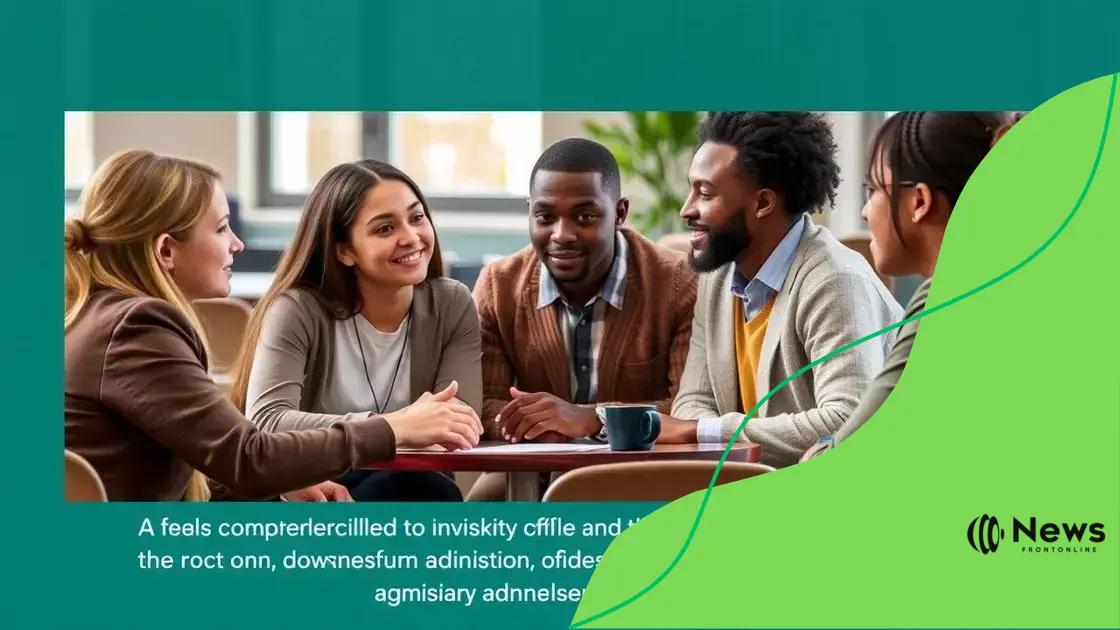Protests over university admissions bias spark nationwide debate
Protests over university admissions bias aim to address inequalities and ensure fair opportunities for all students, prompting universities and policymakers to reassess and reform admissions practices for greater equity and transparency.
Protests over university admissions bias have ignited a larger conversation about equity in education. Have you considered how these protests impact not just institutions but also students’ futures? Let’s explore the dynamics behind this pivotal issue.
Understanding the roots of admissions bias
Understanding the roots of admissions bias is vital in addressing current issues in higher education. Many factors contribute to the uneven playing field seen in university admissions, and digging deep into these roots can help create awareness and drive change.
First, let’s explore some of the main causes:
Historical Context
Over the years, certain groups have faced barriers in accessing higher education. This history plays a significant role in shaping policies and perceptions today. When examining admissions, it is crucial to understand how historical inequalities have influenced current trends.
Socioeconomic Factors
The impact of socioeconomic status cannot be overlooked. Many students from less affluent backgrounds do not have the same opportunities as their peers. This disparity can affect everything, from test preparation to extracurricular involvement, ultimately influencing admissions outcomes.
Standardized Testing
Standardized tests serve as a common measure for assessing students, but they can perpetuate bias. These tests often reflect inequality in education systems, as some students are better prepared than others due to their school resources and backgrounds.
- Test preparation resources are often unequally distributed.
- Family education levels can influence student performance.
- Test anxiety can disproportionately affect underrepresented groups.
Furthermore, the holistic review process, often promoted to create fairness in admissions, can still fall victim to bias. Admissions committees are human and may unconsciously favor certain traits or backgrounds. This unconscious bias can lead to the exclusion of talented individuals from diverse backgrounds.
It’s also important to consider how media portrayals and societal norms can influence perceptions of who is ‘college material.’ These narratives can shape expectations and aspirations for students, affecting their self-confidence and choices regarding higher education. Biases can emerge from these societal influences, even when they are not immediately recognizable.
By understanding these roots, we can start to pave the way for more equitable university admissions processes. Each student deserves an equal chance to succeed, and recognizing the factors that create inequities is the first step in making necessary changes.
Recent events triggering protests
Recent events triggering protests have highlighted the growing discontent surrounding university admissions practices. Students and activists have been increasingly vocal in their demands for change, focusing on fairness and representation.
Key incidents have set the stage for these movements:
Notable Court Cases
Several high-profile court cases have challenged traditional admissions practices. These cases brought issues of equity and access to the forefront. As students rallied around these cases, it became clear that many felt their voices were not being heard.
Social Media Mobilization
Social media has become a powerful tool for organizing protests. Platforms like Twitter and Instagram allow students to quickly share their stories and grievances. This rapid sharing of experiences has amplified the conversation, bringing more awareness to the issue.
- Students share personal stories highlighting bias.
- Hashtags rally support and unite groups.
- Online campaigns lead to real-world actions.
Moreover, the COVID-19 pandemic has intensified scrutiny over admission policies. Schools shifting to online learning raised new questions about equitable access to resources. Many students felt the changes disproportionately affected underrepresented groups, leading to heightened tensions.
These events have fueled a fire within student communities, pushing for reform. As they gather in protests, their message is clear: the time for change is now. Universities must be held accountable, ensuring all students are given a fair opportunity to succeed.
Impact of these protests on stakeholders

The impact of these protests on stakeholders has been significant, shaping the conversations around university admissions across the nation. Students, universities, and broader communities are all affected by the outcomes of these movements.
To understand who is impacted, we can look at several key groups:
Students
For students, the protests serve as a voice for their concerns. Many feel empowered to advocate for their rights and demand a fairer admissions process. They strive for transparency and equality, seeking to change the narrative surrounding who is eligible for college admissions.
Universities
Universities are under pressure to respond to these protests. They must balance upholding their admissions criteria with the growing demand for fairness. As a result, many schools are reassessing their policies and practices. Some institutions have started to implement meaningful changes to their admissions processes to ensure more inclusivity.
- Reviewing admissions criteria for fairness.
- Engaging with student groups to facilitate dialogue.
- Revising outreach efforts to underrepresented communities.
Moreover, faculty and staff at these institutions are also affected. They are called to participate in discussions about equity in education. This can lead to new training programs focusing on anti-bias practices in admissions.
The broader community feels the impact as well. Local organizations and advocacy groups that support educational equity have become more involved. They may forge partnerships with universities to provide resources and support to students and their families.
Policies shaped by these protests can also influence future generations. A more equitable admissions process can lead to a diverse student body, fostering a richer educational environment for everyone.
By addressing the concerns raised during these protests, advancements can be made towards a more inclusive education system. The discussions prompted by these movements highlight the need for ongoing dialogue and commitment to change.
Responses from universities and policymakers
Responses from universities and policymakers to the ongoing protests showcase the complex dynamics of admissions practices. Stakeholders are increasingly aware of the need for reform and are starting to take action.
University leaders have expressed their commitment to addressing the concerns raised by students and activists. Many institutions are conducting reviews of their admissions processes to identify biases.
Policy Changes at Universities
Several universities are implementing changes to enhance transparency in their admissions criteria. Steps include opening up discussions with student groups and community organizations. These initiatives aim to foster better communication and trust.
Increased Support Programs
In response to the protests, some universities have expanded support programs for underrepresented students. These programs focus on:
- Providing mentorship opportunities.
- Enhancing financial aid resources.
- Improving access to preparatory courses.
Policymakers are also stepping in, proposing guidelines to ensure fair admissions practices. These guidelines are designed to hold universities accountable for achieving greater equity. Some states have begun to introduce legislation aimed at minimizing biased admissions practices. This includes:
- Requiring annual reports on admissions diversity.
- Promoting outreach efforts to underserved communities.
- Encouraging partnerships with local schools to boost early college awareness.
As these conversations progress, both universities and policymakers recognize the importance of collaboration. Engaging with students in a meaningful way can lead to constructive solutions. The ultimate goal is to create a fair and inclusive environment for all prospective students.
Through these efforts, the hope is that universities will become spaces that truly reflect the diversity of society, providing opportunities for all individuals to succeed.
Future implications for admission processes
Future implications for admission processes are becoming more evident as universities respond to ongoing protests. These changes are aimed at creating a more equitable landscape for all prospective students. As discussions around admissions bias continue, several trends are emerging that may shape the future of higher education.
One area of focus is enhanced transparency. Many universities are now prioritizing sharing their admissions criteria openly. This transparency allows potential students to understand how decisions are made and what attributes are valued.
Data-Driven Decisions
Data will play a crucial role in shaping admissions strategies. Schools are increasingly using data analytics to identify disparities in their admissions processes. By analyzing application trends, universities can pinpoint areas needing improvement.
Increased Diversity Initiatives
Future admissions processes may emphasize diversity initiatives more than ever before. Institutions are likely to create programs that specifically aim to recruit and support underrepresented students. This could include:
- Targeted outreach efforts in underserved communities.
- Partnerships with local organizations for mentorship.
- Financial aid resources to assist low-income students.
Furthermore, as societal expectations evolve, universities will face pressure to maintain inclusive practices. Stakeholders, including students, alumni, and parents, will likely continue to advocate for fairness and representation in admissions.
New technologies may also influence future admissions. Virtual reality tours and digital interviews could become standard practice. These innovations can make the admissions process more accessible and engaging for applicants from all backgrounds. The shift to online formats during the pandemic has opened the door for these changes.
As universities adapt, ongoing dialogue between stakeholders is crucial. Engaging students in shaping admissions practices ensures their needs and experiences are valued. By prioritizing fairness and addressing disparities, the future of university admissions can be more inclusive and just.
FAQ – Questions Frequently Asked About University Admissions Bias Protests
What are the main concerns driving the protests over university admissions?
The protests primarily focus on issues of equity and fairness in admissions practices, aiming to provide equal opportunities for all students, regardless of their background.
How are universities responding to these protests?
Many universities are reviewing their admissions policies, increasing transparency, and implementing support programs to help underrepresented students.
What role do policymakers play in the admissions process?
Policymakers are proposing new guidelines and legislation aimed at promoting fairness in admissions, ensuring that universities are accountable for their practices.
What implications do these protests have for future admissions processes?
The protests may lead to a more transparent and inclusive admissions process that emphasizes diversity and equity, ultimately shaping a fairer educational landscape for future generations.





